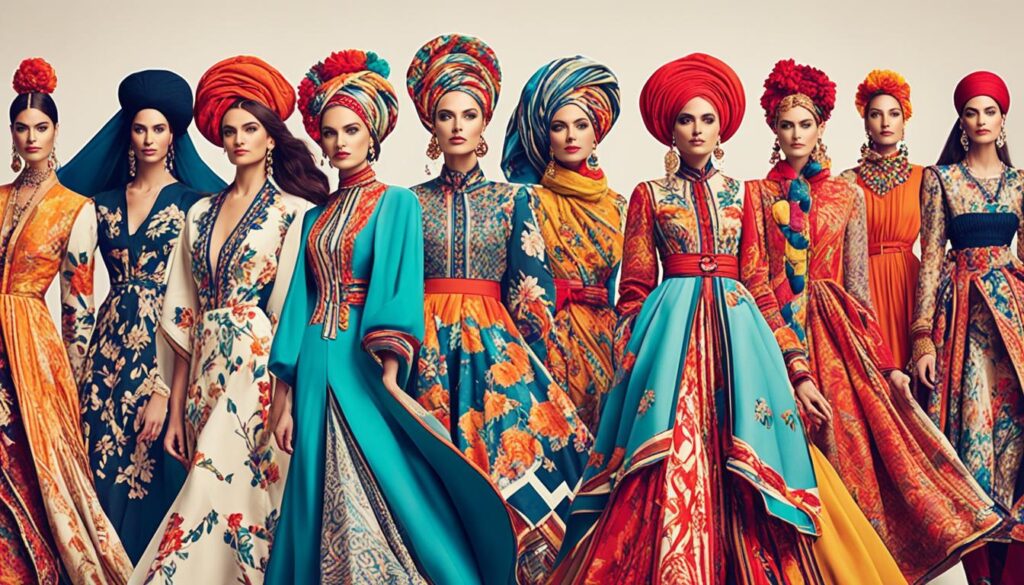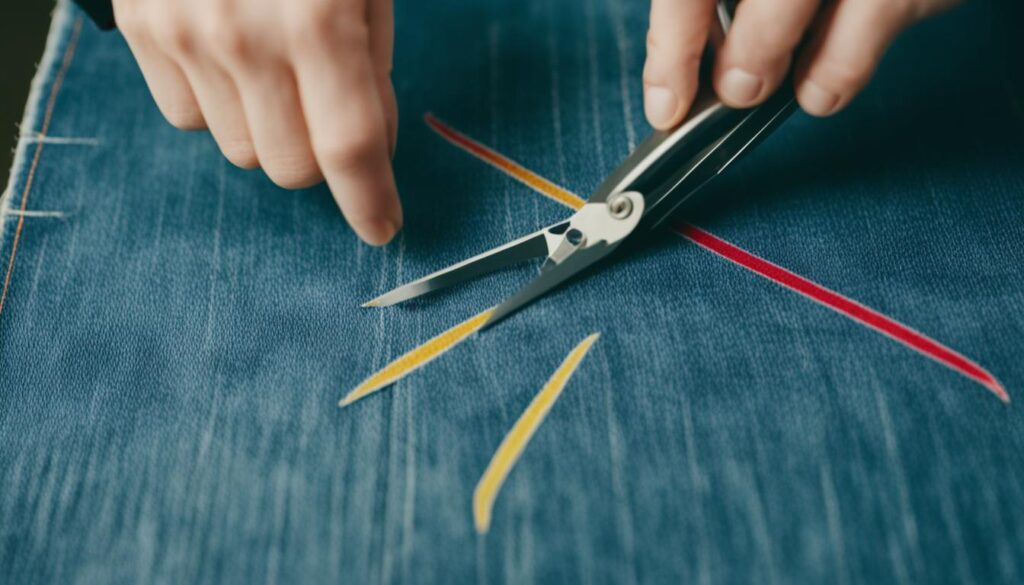Sustainable fashion is more than just a trend. It’s a conscious choice to make a positive impact on the planet by embracing eco-friendly clothing, ethical practices, and organic textiles. The fashion industry has a significant environmental footprint, but by adopting a more sustainable approach, we can reduce waste, carbon emissions, and support fair labor conditions.
Key Takeaways:
- Choosing sustainable fashion helps reduce the industry’s environmental impact.
- Sustainable fashion focuses on using organic textiles and recycled materials.
- Supporting fair labor conditions is a crucial aspect of sustainable fashion.
- Investing in quality, long-lasting clothing reduces the need for frequent purchases.
- Caring for sustainable fashion extends the lifespan of garments and minimizes waste.
What is Sustainable Fashion?
Sustainable fashion is a concept that builds on the principles of sustainable development. It aims to meet the needs of the present without compromising the ability of future generations to meet their own needs.
Sustainable fashion advocates for an industry that manages its environmental impacts and ensures the well-being of people and animals throughout the supply chain. To achieve this, it calls for a shift away from overproduction, overconsumption, waste, worker exploitation, and the climate emergency.
While the term “sustainable fashion” can be broadly used and sometimes subject to greenwashing, it is crucial to focus on the core goals of preserving resources, supporting fair labor practices, and promoting a circular economy.

A circular economy is a fundamental aspect of sustainable fashion. It encourages the reuse, recycling, and upcycling of materials to extend their lifespan and reduce waste. By embracing sustainable fashion, individuals and brands can contribute to the creation of a more sustainable future for the fashion industry.
The Pillars of Sustainable Fashion:
- Preserving Resources: Sustainable fashion emphasizes the use of environmentally friendly materials such as organic cotton, hemp, and recycled fabrics. These materials reduce the negative impact on natural resources, including land, water, and energy.
- Fair Labor Practices: Ethical fashion ensures that workers throughout the supply chain are treated fairly, receiving fair wages, safe working conditions, and protection of their rights.
- Reducing Waste: Sustainable fashion aims to minimize waste by promoting practices such as recycling, upcycling, and designing with longevity in mind.
- Promoting Social Responsibility: Sustainable fashion takes into account the social impact of the industry, striving to create positive change and support communities.
- Respecting Animal Welfare: Ethical fashion considers the welfare of animals, avoiding the use of materials derived from animals and promoting cruelty-free alternatives.
“Sustainable fashion is more than just a trend; it’s a mindset and a commitment to responsible practices that benefit the planet and all its inhabitants.” – Emma Johnson, Founder of Green Fashion Blog
By adopting sustainable fashion practices, individuals and brands can contribute to a more sustainable development model, reducing the environmental impact of the fashion industry, and promoting a more inclusive and fair future for all stakeholders.
| Sustainable Fashion | Conventional Fashion |
|---|---|
| Uses organic and recycled materials | Relies on synthetic and non-renewable materials |
| Focuses on fair trade and ethical labor practices | May exploit workers in low-wage countries |
| Promotes the circular economy | Contributes to the linear economy (take, make, dispose) |
| Emphasizes quality and durability | Encourages fast fashion and disposable clothing |
| Minimizes carbon footprint | Creates high carbon emissions through production and transportation |
| Supports animal welfare | Uses animal-derived materials such as fur and leather |
Benefits of Sustainable Fashion
Sustainable fashion brands, green fashion, and ethical fashion are not only good for the environment but also offer numerous benefits for individuals. By embracing sustainable apparel made from organic textiles, consumers can make a positive impact on both their wardrobes and the planet.
Reduced Carbon Footprint
Choosing sustainable fashion brands that prioritize eco-friendly practices helps reduce carbon emissions. These brands often employ sustainable production methods, such as using renewable energy sources, minimizing water consumption, and implementing efficient waste management systems.
Fair Labor Conditions
Supporting sustainable fashion brands also means supporting fair labor conditions throughout the supply chain. Many sustainable brands prioritize ethical practices, ensuring that workers are paid fairly and have safe working conditions. By opting for ethical fashion, consumers contribute to the fight against worker exploitation and unfair labor practices.
Preservation of Natural Resources
Sustainable fashion advocates for the preservation of natural resources by using organic textiles and reducing waste. Organic textiles are grown without the use of harmful pesticides and chemicals, making them safer for both the wearer and the environment. Additionally, sustainable fashion promotes recycling, upcycling, and the use of recycled materials, minimizing the need for virgin resources.
Long-Lasting, Quality Clothing
Sustainable apparel is known for its high quality and durability. By investing in well-made, long-lasting clothing pieces, individuals can build a stylish and sustainable wardrobe that withstands the test of time. This approach reduces the need for frequent purchases and minimizes waste, contributing to a more sustainable and eco-friendly fashion industry.
| Benefits of Sustainable Fashion |
|---|
| Reduced Carbon Footprint |
| Fair Labor Conditions |
| Preservation of Natural Resources |
| Long-Lasting, Quality Clothing |

How to Start with Sustainable Fashion
Embarking on a journey towards sustainable fashion may seem daunting, but with a few simple steps, you can make a meaningful difference. Here’s a guide to help you get started:
- Educate Yourself: Begin by learning about sustainable fashion brands and their ethical practices. Research and ask questions to ensure that the brands you support align with your values.
- Quality Over Quantity: Instead of purchasing numerous fast-fashion items, focus on investing in high-quality, versatile clothing pieces that can be worn year-round. Look for trans-seasonal garments that offer timeless style and durability.
- Build a Capsule Wardrobe: Consider creating a capsule wardrobe comprised of essential, mix-and-match items. This approach encourages thoughtful consumption and reduces the need for excessive purchases.
- Make Sustainable Choices: Prioritize sustainable fashion brands when buying new items. Look for environmentally-friendly materials, such as organic cotton or recycled fibers, and choose garments that have a minimal impact on the environment.
- Donate and Explore Second-hand: Extend the lifespan of your clothing by donating unwanted items to charity or exploring second-hand options. This reduces waste and allows others to enjoy your pre-loved garments.
“Every little step towards sustainable fashion counts. By educating ourselves, prioritizing quality, and embracing conscious choices, we can make a positive impact on the environment and promote a more sustainable future.”
Starting with sustainable fashion is not only a personal choice but also a powerful statement. Together, we can shift the industry towards a more ethical and eco-friendly approach.
Keep in mind that sustainable fashion is an ongoing journey, and every small step counts. By aligning your choices with sustainable fashion trends and supporting ethical fashion brands, you can actively contribute to a more sustainable and conscious wardrobe.
A Practical Guide to Building a Capsule Wardrobe
A capsule wardrobe is a collection of essential clothing pieces that can be mixed and matched to create various outfits. By curating a well-designed capsule wardrobe, you can minimize clutter, reduce waste, and simplify your daily dressing routine. Here is a step-by-step guide to help you build your own:
| Step | Action |
|---|---|
| 1 | Assess Your Style and Lifestyle |
| 2 | Define Your Color Palette |
| 3 | Identify Essential Clothing Pieces |
| 4 | Choose Versatile and Timeless Items |
| 5 | Optimize with Layering and Accessories |
| 6 | Donate or Sell Unwanted Items |
| 7 | Maintain and Update Your Capsule Wardrobe Regularly |
Remember, developing a capsule wardrobe is a personal journey that should reflect your unique style and needs. Experiment, have fun, and embrace the freedom of dressing with intention.
Caring for Sustainable Fashion
Caring for sustainable fashion is essential to prolong the lifespan of garments and minimize the need for replacements. By adopting proper clothing care practices, individuals can contribute to reducing waste and the environmental impact of the fashion industry. Here are some tips for caring for your sustainable fashion pieces:
- Follow care instructions: Pay attention to the care instructions provided by the manufacturer. Follow the recommended washing, drying, and ironing methods to ensure that your garments remain in good condition.
- Use environmentally-friendly laundry detergents: Opt for eco-friendly laundry detergents that are free from harsh chemicals and pollutants. These detergents are gentle on fabrics and minimize negative impacts on the environment.
- Avoid overwashing: Washing clothes too frequently can wear them out faster and consume excessive water and energy. Only wash your garments when necessary, and consider spot cleaning or airing them out between washes.
- Repair instead of discarding: If you notice a small tear or loose button, fix it yourself or take it to a trusted tailor. Repairing clothing extends its lifespan and reduces the need for replacements.
- Proper storage: Store your sustainable fashion pieces in a clean, dry, and well-ventilated area. Use hangers or fold them neatly to prevent wrinkles, stretching, and damage.
By following these clothing care tips, you can ensure that your sustainable fashion pieces stay in excellent condition for longer. This not only saves you money but also helps protect the environment by reducing waste and promoting a more sustainable approach to fashion.
Conclusion
Sustainable fashion is more than just a passing trend; it is a conscious choice that promotes environmental responsibility and ethical practices in the fashion industry. By embracing sustainable fashion, individuals can make a positive impact on the planet while still looking stylish.
Transitioning to a more sustainable wardrobe starts with education. By learning about sustainable fashion brands and their commitment to ethical practices, consumers can make informed choices that align with their values. Mindful shopping is also essential, prioritizing quality over quantity and investing in timeless pieces that can be worn for years to come.
In addition, caring for garments is crucial to prolong their lifespan and minimize waste. Following care instructions, using eco-friendly laundry detergents, and repairing clothes when needed can significantly reduce the environmental impact of the fashion industry.
Supporting sustainable fashion brands is key to driving positive change in the industry. By choosing to purchase from these brands, consumers send a message that sustainability and ethical practices matter. Together, we can build a more sustainable future where fashion and the planet coexist harmoniously.
















